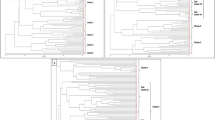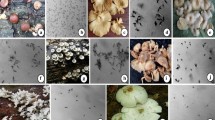Abstract
Amanita ponderosa is a specie of wild edible mushrooms growing spontaneously in some Mediterranean microclimates, namely in Alentejo and Andaluzia, in the Iberian Peninsula. The nutritional values of these fungi make them highly exportable. Due to the wide diversity of mushrooms in nature, it is essential to differentiate and to identify the various edible species. RAPD markers have been used as a valuable tool to distinguish the different genotypes, although this method has not yet been used toAmanita ponderosa. Two methods were used to establish different genetic fingerprinting patterns of edible mushrooms. Samples ofAmanita ponderosa were collected in six different regions of the southwest of the Iberian Peninsula and compared by RAPD-PCR and MSP-PCR. Additionally, to compare molecular profiles with others genera of edible mushrooms, three species of Basidiomycetes (Pleurotus ostreatus, Lactarius deliciosus andCoriolus versicolor) and an Ascomycete were used. Results showed that some molecular markers discriminate among an Ascomycete from Basidiomycetes (Amanita ponderosa, Pleurotus ostreatus, Lactarius deliciosus andCoriolus versicolor) and discriminate among the different genera within basidiomycetes, as it is expected. Moreover, OPF-6, OPG-2, OPG3 and M13 primes allowed to unravel a level of genetic polymorphism withinAmanita ponderosa mushrooms collected from different geographic origin.
Similar content being viewed by others
References
Alves A., Phillips A., Henriques I., Correia A. (2007). Rapid differentiation of species of Botryosphaeriaceae by PCR fingerprinting. Res. Microbiol., 158: 112–121.
Firenzuoli F., Gori L., Lombardo G. (2007). The medicinal mushroomAgaricus blazei Murrill: review of literature and pharmaco-toxicological problems. Advance Access Publication, 5 (1): 3–15.
Godoy J., Negro J., Hiraldo F., Donázar J. (2004). Phylogeography, genetic structure and diversity in the endangered bearded vulture (Gypaetus barbatus, L.) as revealed by mitochondrial DNA. Mol. Ecol., 13: 371–390.
Hseu R., Wang H., Wang H., Moncalvo J. (1996). Differentiation and grouping of isolates of theGanoderma lucidum complex by random amplified polymorphic DNA-PCR compared with grouping on the basis of internal transcribed spacer sequences. Appl. Environ. Microbiol., 62: 1354.
Khush R., Becker E., Wach M. (1992). DNA amplification polymorphisms of the cultivated mushroomAgaricus bisporus. Appl. Environ. Microbiol., 58: 2971.
Lee Y., Chang H., Kim J., Kim J., Lee, K. (2000). Lignocellulolytic mutants ofPleurotus ostreatus induced by gamma-ray radiation and their genetic similarities. Radiat. Phys. Chem., 57: 145–150.
Lopes M., Silva D., Freitas G., Tenreiro R. (2007). Simultaneous identification and typing ofCandida species by MSP-PCR and AFLP: Study of clinical isolates from a Portuguese pediatric hospital. J. Mycol. Médicale, 17: 157–67.
Martin F., Costa G., Delaruelle C., Diez J. (1998). Genomic fingerprinting of ectomycorrhizal fungi by microsatellite-primed PCR. In: Varma A., Ed., Mycorrhiza Manual. Springer-Verlag, Berlin, Heidelberg, New York, pp. 463–474.
Martins M. (2004). Degradação biológica de fungicidas em amostras de solo, Tese de Doutoramento, Departamento de Química, Universidade de Évora, Évora, pp. 140-142.
Moncalvo J., Drehmel D., Vilgalys R. (2000). Variation in modes and rates of evolution in nuclear and mitochondrial ribosomal DNA in the mushroom genusAmanita (Agaricales, Basidiomycota): phylogenetic implications. Mol. Phylogenet. Evol., 16: 8–63.
Moreno G., Platas G., Peláez F., Bernedo M., Vargas A., Daza A., Santamaría C., Camacho M., de la Osa L., Manjón J. (2008). Molecular phylogenetic analysis shows thatAmanita ponderosa andA. Curtipes are distinct species. Mycol. Progr., 7: 41–47.
Moreno-Rojas R., Díaz-Valverde A., Moreno-Arroyo B., González T., Capote C. (2004). Mineral content of gurumelo (Amanita ponderosa). Food Chem., 85: 325–330.
Pacioni G., Leonardi M., Aimola P., Ragnelli A., Rubini A., Paolocci F. (2007). Isolation and characterization of some mycelia inhabitingTuber ascomata. Mycol. Res., III: 1450–1460.
Ro H., Kim S., Ryu J., Jeon C., Leed T., Le H. (2007). Comparative studies on the diversity of the edible mushroomPleurotus eryngii: ITS sequence analysis, RAPD fingerprinting, and physiological characteristics. Mycol. Res. III, 710–715.
Sambrook J., Feitsch E., Maniatis T. (1989). Molecular Cloning: A Laboratory Manual. Cold Spring Harbor Laboratory Press, Cold Spring Harbor, New York.
Zhang Y., Molina F. (1995). Strain typing ofLentinula edodes by random amplified polymorphic DNA assay. FEMS Microbiol. Lett., 131: 17–20.
Author information
Authors and Affiliations
Corresponding author
Rights and permissions
About this article
Cite this article
Caldeira, A.T., Salvador, C., Pinto, F. et al. MSP-PCR and RAPD molecular biomarkers to characterizeAmanita ponderosa mushrooms. Ann. Microbiol. 59, 629–634 (2009). https://doi.org/10.1007/BF03175156
Received:
Accepted:
Issue Date:
DOI: https://doi.org/10.1007/BF03175156




